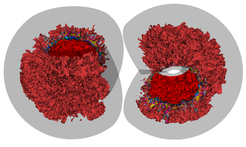
3D Progenitor Modeling
Current multidimensional simulations of the collapse start from progenitor models provided by 1D stellar evolution codes. Unfortunately, 1D stellar evolution models suffer from uncertainties due to the lack of a consistent description of the (magneto-)hydrodynamical transport processes of heat, chemical species, and angular momentum that shape the interior of stars. For instance, despite its well-known shortcomings, mixing-length theory has been used since 60 years to describe convection. As a result, 1D stellar evolution models computed until the onset of collapse suffer from several uncertainties, for example: how is the typical shell structure of the core predicted by 1D stellar evolution modified by hydrodynamical mixing processes such as, e.g., convective overshoot? Are the internal rotation profiles delivered by 1D stellar evolution realistic? One of the goals of this project is to revisit our knowledge of the late stages of stellar evolution using multidimensional simulations, which include hydrodynamical effects self-consistently.

Furthermore, preliminary studies have shown that large-scale perturbations due to convection in the silicon and oxygen burning shells lying above the collapsing iron core could play a role in reviving the standing accretion shock. Here again, 1D progenitor models are limited as they are based on the mixing-length theory. One of the main goals of this project is therefore to conduct 3D hydrodynamical simulations of the very last hours before the collapse, in order to deliver more realistic 3D progenitors models for the study of the collapse mechanism.
Such simulations are at the forefront of computational astrophysics as they require the solution of the hydrodynamical equations in full 3D coupled with the transport of multiple chemical species (20 at the moment) and a nuclear network. For this purpose, we have adapted the Vertex-Prometheus code to model the quasi-hydrostatic pre-collapse phases. The figure on the left shows a snapshot of a calculation of the convection in the oxygen burning shell of a 20 solar-mass progenitor. The calculation uses a Yin-Yang grid to perform 4pi-shell simulations without the drawbacks of standard spherical polar coordinates.
